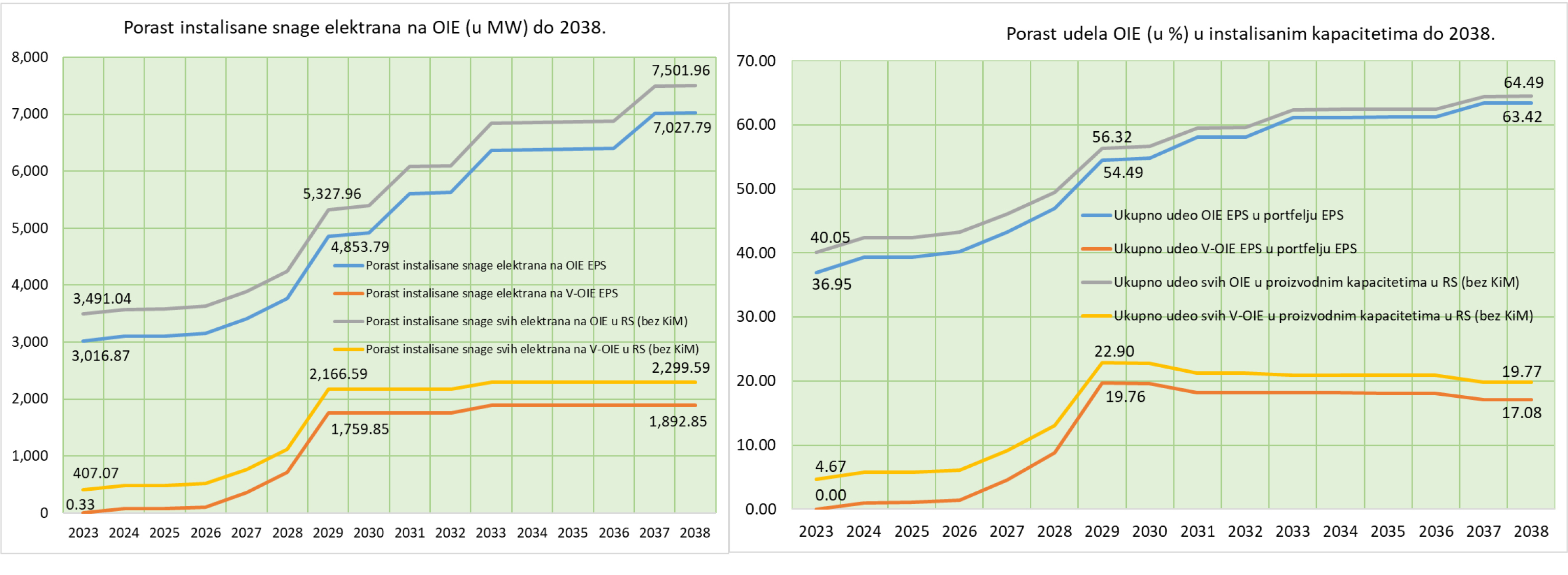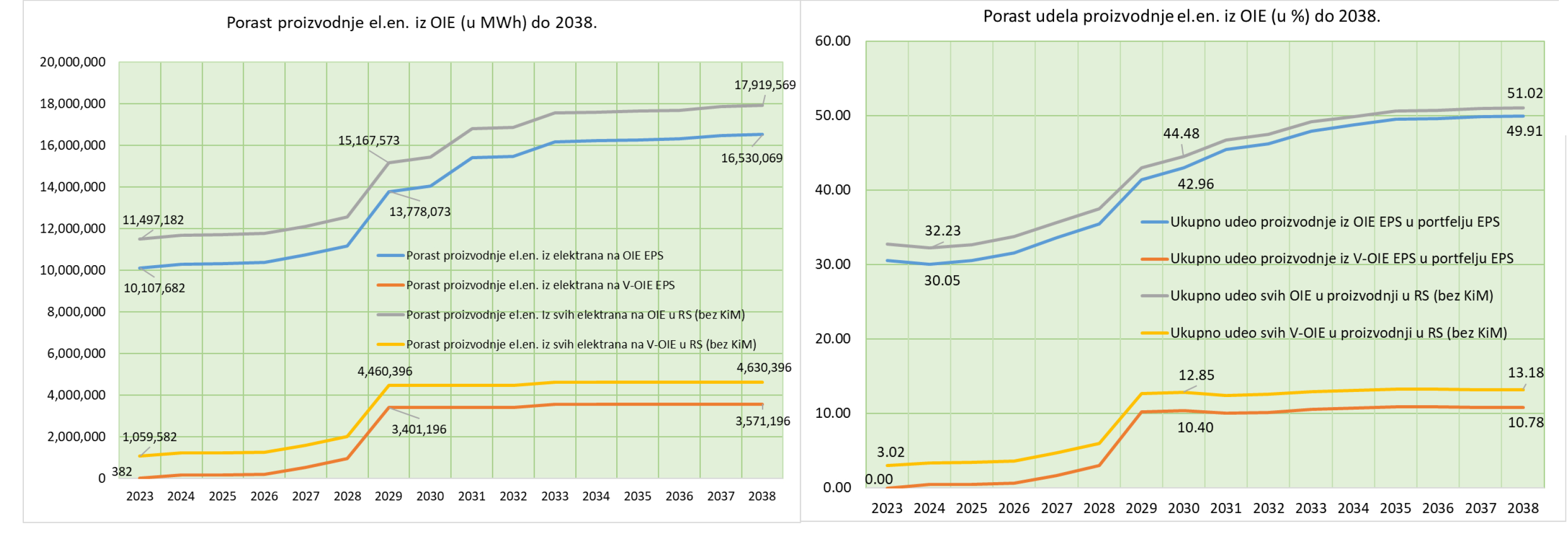

New green megawatts are the strategic commitment of Elektroprivreda Srbije and this is confirmed by the Green Road of EPS, a document uniting the most important investment projects in the RES field. Base energy from coal is the reality of our electricity sector. Nonetheless, along the path of decarbonization and energy transition, pivoting towards RES is the only way for the energy sector to be the mainstay of Serbia’s economic development in the coming decades.
- RES development investments and strengthening the green portfolio are a sure way for EPS to remain one of the strongest energy players in the Western Balkans - says Miroslav Tomasevic, acting director of EPS. – Based on current estimates, in the next 15 years, the RES share in EPS’ generation portfolio could increase from the current slightly over 3,000 megawatts to more than 7,000 megawatts by 2038, which is more than a double increase in the capacity of RES power plants. Implementation of the planned investments, valued at some EUR 4.8 billion, would boost EPS energy levels for about 4,000 new megawatts.
In this way, RES share in the total installed capacity of EPS would increase from 36.9 percent to about 63 percent by 2038. With the implementation momentum of these investment projects, RES generation of EPS would increase from the current 10,000 gigawatt-hours to 16,500 gigawatt-hours in 2038, which would increase the current 30 percent of energy generated from RES to almost half of the total generation. As pointed out by the acting director of EPS, the largest jump in the RES share is planned in the next seven to eight years, while continuous development and implementation of projects will continue from 2031 to 2038. Tomasevic points out that certain projects planned as part of the Green Road of EPS have already received the support and green light of the European Union. As part of the 28th call for technical assistance from the EU Western Balkan Investment Framework (WBIF) and the 7th call for co-financing of investment projects through WBIF, EPS received a development grant totalling EUR 49.02 million. This includes four projects: revitalisation of Vlasina hydropower plants – EUR 16.1 million, construction of the Kostolac wind farm – EUR 31.2 million and drafting investment - technical documentation for the development of the Morava and Kolubara A solar power plants – EUR 860,000 each. European officials positively evaluated EPS projects and extended support, which is an incentive for future projects and proof that EPS is on the right track. As a consequence, the European Investment Bank expressed its willingness to co-finance revitalisation projects of the existing hydropower plants Bistrica, Potpec and Djerdap 2, as well as the construction of the pumped-storage hydropower plant (PSHPP) Bistrica.
According to the head of EPS, the most significant RES projects of EPS include the construction of hydropower capacities, as well as wind and solar power plants. In 2024, completion of the 66-megawatt wind farm in Kostolac is expected, valued at EUR 118.64 million. In the same year, Petka solar power plant should be finished, with the capacity of almost 10 megawatts, while it is expected that tenders for the contractor will be invited in the first quarter of this year. The works tender for the solar power plant on the TENT A rooftops, which should also generate the first green energy starting in 2024, is underway. Tomasevic says that a year later, there are plans to install solar panels on rooftops of another large thermal power plant, TENT B. 71 and 45 megawatts of solar power will be installed on the ash disposal sites of the Kolubara A and Morava thermal power plants, with EBRD and KfW assistance announced, while in the area of Kostolac, solar power plants Srednje Kostolacko ostrvo, with the capacity of 97 megawatts and Klenovnik of about 250 megawatts are planned. Possible further wind potential utilisation has also not been overlooked, as two wind farms of 500 megawatts each are planned at the Stisko Polje location near Kostolac, with the total investment estimated at EUR 1.5 billion.
- The necessary energy reserve to balance variable renewable sources - solar and wind - will be provided by a key project as part of the green scenario – PSHPP Bistrica, with the planned capacity of 628 megawatts. This project brings multiple benefits to the entire power system. It will facilitate the entry of new clean megawatts from solar and wind power plants, while it could be online by 2031, i.e. in time to ease introduction of the planned variable RES power plants in the medium term - says Tomasevic.
Further green scenario developments will require additional support in terms of energy storage. This will require development and implementation of the ambitious PSHPP Djerdap 3 project, in two phases, until 2037. It will add two times 600 megawatts to the grid. Finishing planned power plant revitalisations in time is also of crucial importance for energy security - it is carefully prepared and carried out, reinforcing the rule that energy activities must be planned years in advance. In addition to increasing power plant reliability, revitalisations extend their operating life and bring additional megawatts of installed capacity and valuable gigawatt-hours of electricity. Therefore, in the coming years, EPS plans to revitalise HPP Bistrica, which should be completed by 2027. It is also planning to revitalise and increase the capacity by 40 megawatts in HPP Djerdap 2, in stages on all 10 units, until 2032. A new total of 11.8 megawatts, as part of the revitalisation, will also be received by Vlasina hydropower plants and three units of HPP Potpec, with the previous installation of the fourth 12.7-megawatt unit of HPP Potpec.
- This strategic development scenario of EPS, based on RES use in Serbia, would expedite gradual reduction in the use of the now dominant energy source - lignite. Until it has completely been replaced by another base energy source, new, green energy would increasingly contribute to the energy security and independence of Serbia and EPS. This is essential during the current energy crisis, when energy and energy products are firmly established as key factors for the survival and development of national economies - explained Tomasevic.
